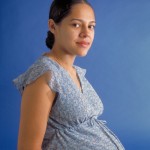Major depressive disorder (MDD) affects approximately 10% to 15% of pregnant patients, causing maternal distress, increased risk of suicide, life-threatening obstetric complications, and lasting neurodevelopmental effects on offspring.1–4 The strongest evidence-based treatments for MDD during pregnancy are psychotherapy and pharmacotherapy, typically with selective serotonin reuptake inhibitors (SSRIs), but these may not always be viable or acceptable options for patients due to symptom severity, the need for rapid symptom resolution, and perceived concerns about the effects of medications on fetal development.1,5 Therefore, non-pharmacologic neuromodulation therapies such as transcranial magnetic stimulation (TMS) have gained interest and research attention.
TMS is an FDA-approved, non-invasive, and safe neuromodulation therapy for MDD that uses magnetic pulses to stimulate specific areas of the brain associated with psychiatric disorders.6 Unlike pharmacotherapy or other forms of neuromodulation, TMS has no systemic side effects and does not induce a seizure or require anesthesia. Furthermore, the electric field generated is far below the safety limit recommended in pregnant patients.7 TMS has also been safely used in pregnant patients for neurological indications.7,8 To learn more about TMS click here.
TMS for Depression During Pregnancy
Although there are currently no guidelines for the use of TMS in pregnancy, several recent studies show promising results with minimal side effects. For studies before 2015 click here. A randomized control trial of 22 pregnant patients in the second or third trimester showed that TMS delivered to the right dorsolateral prefrontal cortex (DLPFC) at 1 Hz over 20 sessions had higher response and remission rates compared to a sham group.9 Patients received a single train of 900 pulses per session at 100% motor threshold (MT) five times a week for 4 weeks. Estrogen and progesterone levels remained stable before and after TMS treatment, and there were no major side effects experienced by the mother or baby in the treatment group.
Additionally, several case reports of patients treated with TMS during the first and second trimesters with various stimulation parameters have been published. Some experienced treatment response while continuing SSRIs or psychotherapy. Three patients experienced treatment response from TMS delivered to the left DLPFC at 10 Hz for 5 sessions a week for 4 weeks for 3,000 pulses per session at 120% of MT.10 Two patients also responded after receiving right DLPFC stimulation at 1 Hz for 5 sessions a week for 4 weeks for a total of 1,800 pulses per session at 120% of MT.10,11 One patient delivered twins at late preterm (36 weeks). Of note, twin pregnancies are an established factor associated with delivery before term at 37 weeks.12 Patients reported no major side effects, obstetric complications, or congenital malformations.
Special Considerations in Pregnancy
The most common side effects of TMS in all patient populations, including pregnancy, are transient scalp pain and headache.13 The only pregnancy-related complication from TMS that has occurred in more than one patient is supine hypotensive syndrome.14 In supine hypotensive syndrome, the inferior vena cava becomes compressed by the gravid uterus when a pregnant patient is supine, decreasing venous return. To mitigate this risk, it is advised that patients over 24 weeks gestational age be positioned on their left side using a wedge cushion with at least a 30-degree left pelvic tilt while receiving low-frequency right-sided TMS.14
One newer TMS protocol, theta burst stimulation (TBS), may be a preferable option as it reduces the risk of supine hypotension during treatment. TBS works by simulating hippocampal theta electroencephalography rhythms, which are thought to induce long-term plasticity in neurons.15,16 Conventional repetitive TMS (rTMS) sessions last up to 37.5 minutes, while intermittent TBS protocols last 3 minutes, reducing cost and time burden to patients.17 TBS is equivalent to rTMS in efficacy, safety, durability, and tolerability, and was FDA-approved for the treatment of MDD in 2018.17 Several cases of successful treatment of MDD with TBS during pregnancy have been reported, with 15 patients safely undergoing treatment during all three trimesters.18-21 One patient had meconium-stained amniotic fluid, but no other obstetric or fetal complications were noted.18
TMS in the Postpartum Period
TMS also shows promise as an effective, safe, and durable treatment for postpartum depression (PPD). In a 2016 multi-center open-label study of 19 patients, 14 achieved remission of PPD from TMS monotherapy with no serious adverse events.20 Patients in this study were treated with TMS delivered to the left DLPFC at 10 Hz for 5 sessions a week for 4-8 weeks. They received 3,000 total pulses of TMS per session at 120% of MT. Additionally, a 2020 case series of 6 patients with PPD were treated with open-label TMS using the same parameters.23 Of the 6 patients, 2 patients’ depression responded to TMS, and 4 reached remission, which was sustained at 6-month follow-up. There were no major side effects including effects on lactation.
Future Directions
TMS in pregnancy and the postpartum period appears to be a promising treatment option with no reports of adverse obstetric outcomes or congenital malformations. However, the majority of the data currently available consists of case reports, and a single randomized controlled trial that yielded encouraging results but was limited by a small sample size. Recruitment of patients for studies on TMS may be challenging, as many are not familiar with the treatment. Prior studies have demonstrated that providing patients with informational videos about TMS can increase their knowledge and willingness to pursue the treatment.24
Limitations of the current literature include variations in treatment parameters such as high versus low frequency, right versus left stimulation, trimester of exposure, and standard rTMS versus TBS. Future research could focus on effectively identifying patients who may benefit from TMS and educating them about the treatment. To further support the results of the 2019 trial, controlled double-blind studies with larger sample sizes are necessary to assess the long-term safety and efficacy of TMS for both patients and offspring exposed in utero.
Emily Beydler, MD
References
- Stewart DE, Vigod S. Postpartum Depression. N Engl J Med. 2016;375(22):2177-2186. doi:10.1056/NEJMcp1607649
- Kim DR, Sockol LE, Sammel MD, Kelly C, Moseley M, Epperson CN. Elevated risk of adverse obstetric outcomes in pregnant women with depression. Arch Womens Ment Health. 2013;16(6):475-482. doi:10.1007/s00737-013-0371-x
- Wisner KL, Sit DKY, McShea MC, et al. Onset timing, thoughts of self-harm, and diagnoses in postpartum women with screen-positive depression findings. JAMA Psychiatry. 2013;70(5):490-498. doi:10.1001/jamapsychiatry.2013.87
- American College of Obstetricians and Gynecologists (ACOG). ACOG committee opinion no. 757: screening for perinatal depression. Obstet Gynecol. 2018;132(5):e208-e212. doi:10.1097/AOG.0000000000002927
- Battle CL, Zlotnick C, Pearlstein T, et al. Depression and breastfeeding: which postpartum patients take antidepressant medications? Depress Anxiety. 2008;25(10):888-891. doi:10.1002/da.20299
- George MS, Lisanby SH, Avery D, et al. Daily left prefrontal transcranial magnetic stimulation therapy for major depressive disorder: a sham-controlled randomized trial. Arch Gen Psychiatry. 2010;67(5):507-516. doi:10.1001/archgenpsychiatry.2010.46
- Damar U, Lee Kaye H, Smith NA, Pennell PB, Rotenberg A. Safety and tolerability of repetitive transcranial magnetic stimulation during pregnancy: A case report and literature review. J Clin Neurophysiol. 2020;37(2):164-169. doi:10.1097/WNP.0000000000000552
- Guerrero Solano JL, Molina Pacheco E. Low-Frequency rTMS Ameliorates Akathisia During Pregnancy. J Neuropsychiatry Clin Neurosci. 2017;29(4):409-410. doi:10.1176/appi.neuropsych.17030053
- Kim DR, Wang E, McGeehan B, et al. Randomized controlled trial of transcranial magnetic stimulation in pregnant women with major depressive disorder. Brain Stimulat. 2019;12(1):96-102. doi:10.1016/j.brs.2018.09.005
- Ferrão YA, da Silva R de MF. Repetitive transcranial magnetic stimulation for the treatment of major depression during pregnancy. Rev Bras Psiquiatr. 2018;40(2):227-228. doi:10.1590/1516-4446-2017-2522
- Martínez-Gras I, Jurado-Barba R, Sánchez-Pastor L, Rubio G, Prieto-Montalvo J. Antidepressant effect r TMS during pregnancy in a case of Major Depression Resistant to Pharmacological Treatment. Actas Esp Psiquiatr. 2021;49(6):282-285.
- Roman A, Ramirez A, Fox NS. Prevention of preterm birth in twin pregnancies. American Journal of Obstetrics & Gynecology MFM. 2022;4(2S):100551. doi:10.1016/j.ajogmf.2021.100551
- Janicak PG, O’Reardon JP, Sampson SM, et al. Transcranial magnetic stimulation in the treatment of major depressive disorder: a comprehensive summary of safety experience from acute exposure, extended exposure, and during reintroduction treatment. J Clin Psychiatry. 2008;69(2):222-232. doi:10.4088/jcp.v69n0208
- Kim DR, Wang E. Prevention of supine hypotensive syndrome in pregnant women treated with transcranial magnetic stimulation. Psychiatry Res. 2014;218(1-2):247-248. doi:10.1016/j.psychres.2014.04.001
- Suppa A, Huang YZ, Funke K, et al. Ten years of theta burst stimulation in humans: established knowledge, unknowns and prospects. Brain Stimulat. 2016;9(3):323-335. doi:10.1016/j.brs.2016.01.006
- Diamond DM, Dunwiddie TV, Rose GM. Characteristics of hippocampal primed burst potentiation in vitro and in the awake rat. J Neurosci. 1988;8(11):4079-4088. doi:10.1523/JNEUROSCI.08-11-04079.1988
- Blumberger DM, Vila-Rodriguez F, Thorpe KE, et al. Effectiveness of theta burst versus high-frequency repetitive transcranial magnetic stimulation in patients with depression (THREE-D): a randomised non-inferiority trial. Lancet. 2018;391(10131):1683-1692. doi:10.1016/S0140-6736(18)30295-2
- Sylvén SM, Gingnell M, Ramirez A, Bodén R. Transcranial magnetic intermittent theta-burst stimulation for depression in pregnancy – A case series. Brain Stimulat. 2020;13(6):1665-1667. doi:10.1016/j.brs.2020.09.013
- Trevizol AP, Vigod SN, Daskalakis ZJ, Vila-Rodriguez F, Downar J, Blumberger DM. Intermittent theta burst stimulation for major depression during pregnancy. Brain Stimulat. 2019;12(3):772-774. doi:10.1016/j.brs.2019.01.003
- Brock DG, Demitrack MA, Groom P, et al. Effectiveness of NeuroStar transcranial magnetic stimulation (TMS) in patients with major depressive disorder with postpartum onset. Brain Stimulat. 2016;9(5):e7. doi:10.1016/j.brs.2016.06.023
- Yee A, Pedersen E, Koo M. A case series of repetitive transcranial magnetic stimulation in the treatment of major depression during pregnancy. Brain Stimulat. 2022;15(2):373-375. doi:10.1016/j.brs.2022.01.021kim
- Yee A, Pedersen E, Koo M. Repetitive Transcranial Magnetic Stimulation in the Treatment of Major Depression during Pregnancy: A Case Series. Brain Stimulat. 2021;14(5):1407-1408. doi:10.1016/j.brs.2021.07.033
- Cox EQ, Killenberg S, Frische R, et al. Repetitive transcranial magnetic stimulation for the treatment of postpartum depression. J Affect Disord. 2020;264:193-200. doi:10.1016/j.jad.2019.11.069
- Kim DR, Sockol L, Barber JP, et al. A survey of patient acceptability of repetitive transcranial magnetic stimulation (TMS) during pregnancy. J Affect Disord. 2011;129(1-3):385-390. doi:10.1016/j.jad.2010.08.027








Leave A Comment